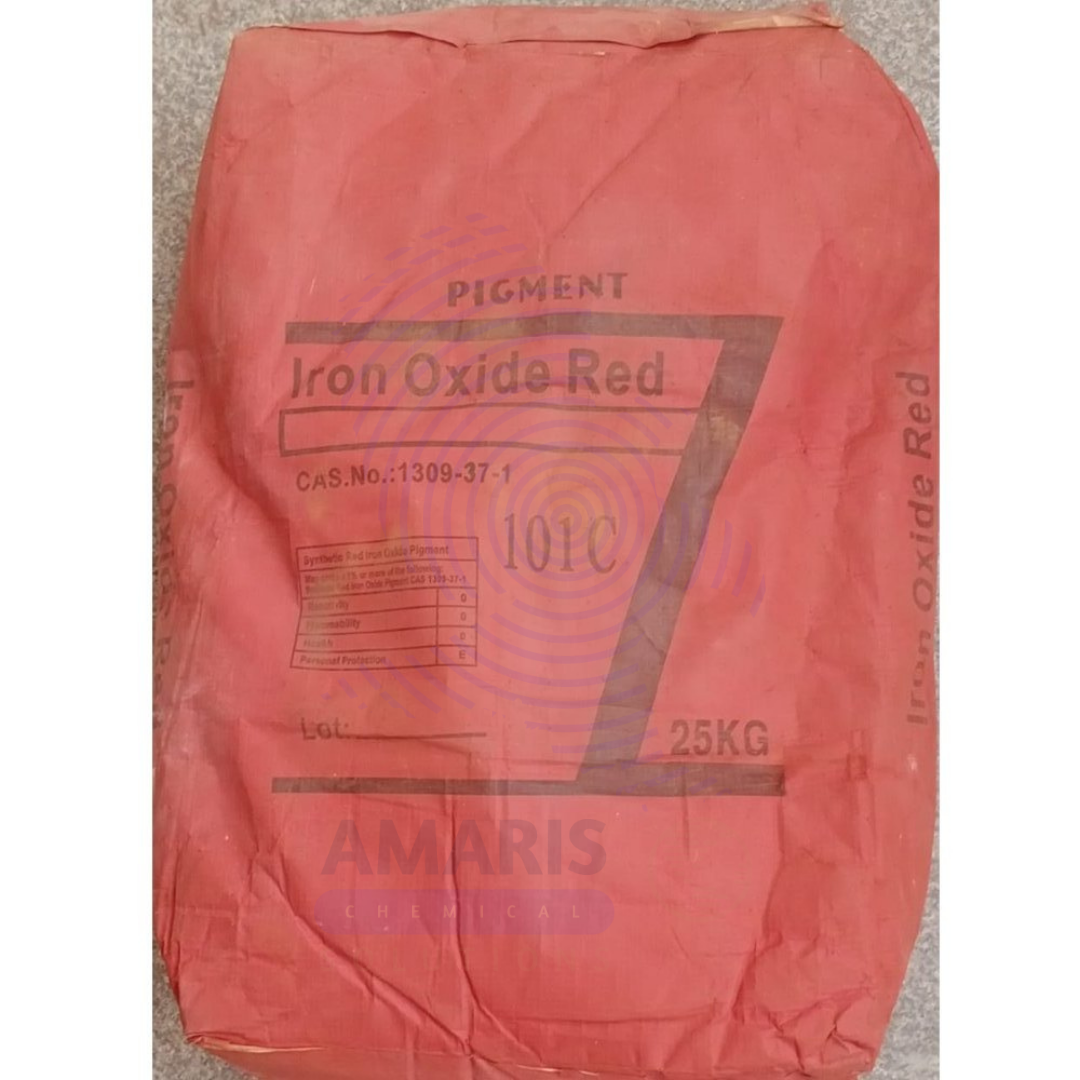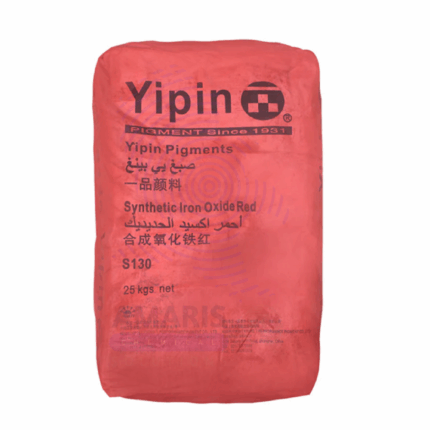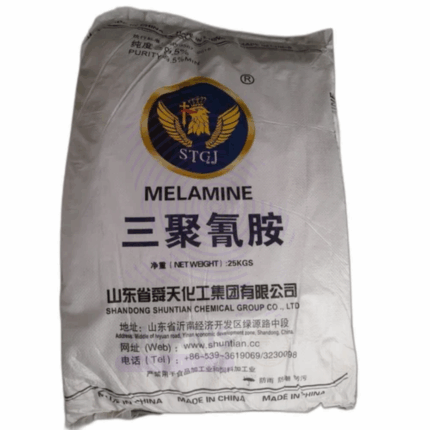Red Oxide S110
Red Oxide S110 is a synthetic iron oxide pigment known for its consistent reddish-brown color, excellent tinting strength, and superior weather and UV resistance. It is commonly used in paints, construction materials, plastics, ceramics, and inks. With excellent chemical stability, dispersibility, and opacity, Red Oxide S110 is a preferred pigment for both functional and decorative applications. It performs well in both solvent- and water-based systems and is suitable for indoor and outdoor use due to its resistance to fading and corrosion.
Red Oxide S110
Primary Uses
Paints & Coatings
Used in metal primers for anticorrosive protection of steel structures, bridges, and marine vessels.
Incorporated into industrial and protective coatings for equipment, pipes, and machinery.
Used in architectural paints for both residential and commercial projects requiring durable exterior coatings.
Added to powder coatings and automotive coatings for stable red hues and rust-resistant base coats.
Construction Materials
Widely used to color concrete, cement blocks, pavers, and tiles, offering long-lasting, non-fading coloration.
Used in ready-mix concrete, plasters, grouts, and stucco finishes for consistent color throughout.
Provides UV-resistant color for roof tiles, façade elements, and artificial stone products.
Plastics Industry
Utilized in PVC, HDPE, and polypropylene manufacturing to provide deep red coloration in pipes, fittings, and containers.
Offers good color fastness and stability under extrusion and injection molding conditions.
Ceramics & Tiles
Applied in ceramic glazes, terracotta products, and roofing tiles for natural red tones.
Maintains color integrity under high-temperature firing.
Printing Inks
Used in screen printing and packaging inks for coloring on paper, plastic films, and textiles.
Offers excellent opacity and UV resistance for long-lasting prints.
Secondary Uses
Rubber Compounding
Used in colored rubber parts for automotive and industrial use due to chemical resistance and UV durability.
Art Supplies
Incorporated into artist paints, chalks, and pastels as a stable earth pigment.
Preferred in restoration and historic preservation for authentic coloration.
Paper Manufacturing
Used to impart reddish tints in decorative and specialty papers.
Cosmetics (if cosmetic-grade)
In cosmetic-grade form, used in lipsticks, blushes, and foundations for natural red tones. (Only applicable to cosmetic-certified grades.)
Educational & Research
Employed in material science and color formulation studies for pigment stability and dispersion properties.
Basic Identification Attributes
Chemical Name (IUPAC): Iron(III) oxide
Common/Trade Name: Red Oxide S110
CAS Number: 1309-37-1
HS Code: 2821.10.00
Synonyms: Synthetic red iron oxide, ferric oxide, Fe₂O₃
Physical & Chemical Properties
Physical State: Fine powder
Color & Odor: Reddish-brown; odorless
Solubility: Insoluble in water and solvents
Density: ~5.0–5.2 g/cm³
Oil Absorption: Moderate (varies by batch)
Particle Size: Micronized for high dispersion
Heat Resistance: Stable up to ~1000°C
Safety & Hazard Attributes
GHS Classification: Not classified as hazardous under normal use
Toxicity: Non-toxic; inert under standard application conditions
Exposure Limits: Avoid inhalation of dust; use protective measures
Storage & Handling Attributes
Storage Conditions: Store in a dry, well-ventilated area away from moisture and incompatible substances
Container Type: Moisture-resistant bags, fiber drums, or HDPE containers
Shelf Life: Indefinite under proper storage conditions
Handling Precautions: Avoid dust formation; use PPE and ventilation during handling
Regulatory & Compliance Attributes
Complies with ASTM D769 standards for pigments
May conform to REACH, RoHS, and EN71 for non-toxic, heavy-metal-free pigments
APEO-free and suitable for use in eco-friendly formulations (if certified)
Environmental & Health Impact
Biodegradability: Inorganic, not biodegradable
Ecotoxicity: Low; considered safe for the environment under controlled use
Bioaccumulation: Not expected
Waste Disposal: Dispose of in accordance with local and national regulations for inert materials
PPE Required: Dust mask, gloves, goggles, and protective clothing
Handling Guidelines: Minimize airborne dust; use appropriate extraction systems
Storage Measures: Keep containers tightly closed and stored in a dry environment to prevent moisture absorption
First Aid Measures
Inhalation: Move to fresh air; seek medical help if breathing becomes difficult
Skin Contact: Wash with water and soap; consult doctor if irritation occurs
Eye Contact: Rinse thoroughly with water; seek medical attention if discomfort persists
Ingestion: Rinse mouth; not expected to be toxic, but seek medical advice
Firefighting Measures
Fire Hazards: Non-combustible; stable under fire conditions
Extinguishing Media: Use water spray, foam, dry chemical, or CO₂ on surrounding materials
Special Precautions: Use self-contained breathing apparatus when dealing with packaging fires
Hazardous Combustion Products: None from pigment itself; packaging may release CO, CO₂


 Preservatives(food)
Preservatives(food) Flavor Enhancers
Flavor Enhancers Acidulants
Acidulants Sweeteners
Sweeteners Antioxidants
Antioxidants Colorants(food)
Colorants(food) Nutraceutical Ingredients (food)
Nutraceutical Ingredients (food) Nutrient Supplements
Nutrient Supplements Emulsifiers
Emulsifiers
 Collectors
Collectors Dust Suppressants
Dust Suppressants Explosives and Blasting Agents
Explosives and Blasting Agents Flocculants and Coagulants
Flocculants and Coagulants Frothers
Frothers Leaching Agents
Leaching Agents pH Modifiers
pH Modifiers Precious Metal Extraction Agents
Precious Metal Extraction Agents
 Antioxidants(plastic)
Antioxidants(plastic) Colorants (Pigments, Dyes)
Colorants (Pigments, Dyes) Fillers and Reinforcements
Fillers and Reinforcements Flame Retardants
Flame Retardants Monomers
Monomers Plasticizers
Plasticizers Polymerization Initiators
Polymerization Initiators Stabilizers (UV, Heat)
Stabilizers (UV, Heat)
 Antifoaming Agents
Antifoaming Agents Chelating Agents
Chelating Agents Coagulants and Flocculants
Coagulants and Flocculants Corrosion Inhibitors
Corrosion Inhibitors Disinfectants and Biocides
Disinfectants and Biocides Oxidizing Agents
Oxidizing Agents pH Adjusters
pH Adjusters Scale Inhibitors( water)
Scale Inhibitors( water)
 Antioxidants(cosmetic)
Antioxidants(cosmetic) Emollients
Emollients Fragrances and Essential Oils
Fragrances and Essential Oils Humectants
Humectants Preservatives
Preservatives Surfactants(cosmetic)
Surfactants(cosmetic) Thickeners
Thickeners UV Filters
UV Filters
 Fertilizers
Fertilizers Soil Conditioners
Soil Conditioners Plant Growth Regulators
Plant Growth Regulators Animal Feed Additives
Animal Feed Additives Biostimulants
Biostimulants Pesticides (Herbicides, Insecticides, Fungicides)
Pesticides (Herbicides, Insecticides, Fungicides)
 Active Pharmaceutical Ingredients (APIs)
Active Pharmaceutical Ingredients (APIs) Excipients
Excipients Solvents(pharmaceutical)
Solvents(pharmaceutical) Antibiotics
Antibiotics Antiseptics and Disinfectants
Antiseptics and Disinfectants Vaccine Adjuvants
Vaccine Adjuvants Nutraceutical Ingredients (pharmaceutical)
Nutraceutical Ingredients (pharmaceutical) Analgesics & Antipyretics
Analgesics & Antipyretics
 Analytical Reagents
Analytical Reagents Solvents(lab)
Solvents(lab) Chromatography Chemicals
Chromatography Chemicals Spectroscopy Reagents
Spectroscopy Reagents microbiology-and-cell-culture-reagents
microbiology-and-cell-culture-reagents Molecular Biology Reagents
Molecular Biology Reagents Biochemical Reagents
Biochemical Reagents Inorganic and Organic Standards
Inorganic and Organic Standards Laboratory Safety Chemicals
Laboratory Safety Chemicals Specialty Laboratory Chemicals(Special Laboratory Equipment)
Specialty Laboratory Chemicals(Special Laboratory Equipment)
 Demulsifiers
Demulsifiers Hydraulic Fracturing Fluids
Hydraulic Fracturing Fluids Scale Inhibitors(oil)
Scale Inhibitors(oil) Surfactants(oil)
Surfactants(oil) Drilling Fluids
Drilling Fluids
 Dyes and Pigments
Dyes and Pigments Bleaching Agents
Bleaching Agents Softening Agents
Softening Agents Finishing Agents
Finishing Agents Antistatic Agents
Antistatic Agents
 Admixtures
Admixtures Waterproofing Agents
Waterproofing Agents Sealants and Adhesives
Sealants and Adhesives Curing Compounds
Curing Compounds Concrete Repair Chemicals
Concrete Repair Chemicals Anti-Corrosion Coatings
Anti-Corrosion Coatings
 Surfactants(cleaning)
Surfactants(cleaning) Builders
Builders Enzymes
Enzymes Solvents (Cleaning)
Solvents (Cleaning) Fragrances
Fragrances
 Electronic Chemicals
Electronic Chemicals Catalysts
Catalysts Lubricants
Lubricants Photographic Chemicals
Photographic Chemicals Refrigerants
Refrigerants Automotive chemicals
Automotive chemicals Pyrotechnic Chemicals
Pyrotechnic Chemicals
 Biodegradable Surfactants
Biodegradable Surfactants Bio-based Solvents
Bio-based Solvents Renewable Polymers
Renewable Polymers Carbon Capture Chemicals
Carbon Capture Chemicals Wastewater Treatment Chemicals
Wastewater Treatment Chemicals
 Pigments
Pigments Solvents(paint)
Solvents(paint) Specialty Coatings
Specialty Coatings Binders/Resins
Binders/Resins Additives
Additives Driers
Driers Anti-Corrosion Agents
Anti-Corrosion Agents Functional Coatings
Functional Coatings Application-Specific Coatings
Application-Specific Coatings
 Fresh Herbs
Fresh Herbs Ground Spices
Ground Spices Whole Spices
Whole Spices Spice Blends
Spice Blends Dried Herbs
Dried Herbs
 Leavening Agents
Leavening Agents Dough Conditioners
Dough Conditioners Flour Treatments
Flour Treatments Fat Replacers
Fat Replacers Decoratives
Decoratives Preservatives(baking)
Preservatives(baking)
 Plasticizers & Softeners
Plasticizers & Softeners Reinforcing Agents
Reinforcing Agents Adhesion Promoters
Adhesion Promoters Vulcanizing Agents
Vulcanizing Agents Antidegradants
Antidegradants Blowing Agents
Blowing Agents Fillers & Extenders
Fillers & Extenders Accelerators & Retarders
Accelerators & Retarders






















